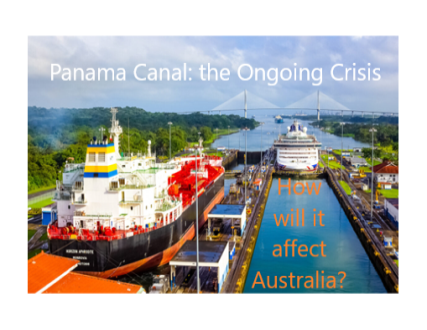The Panama Canal Authority is implementing additional vessel reductions in an effort to conserve water as a drought – exacerbated by a severe El Nino weather system – continues to plague water levels in the locks of this key global trade conduit. See our previous article: Disruptions to Panama Canal.
This month the ongoing drought has forced authorities to reduce the number of daily transits from 29 to 25 ships and, in subsequent months, they will reduce vessel transits even more until it gets down to 18 ships a day in February. That represents between 40% to 50% of full capacity – under normal conditions, between 34-36 vessels traversed the canal daily
How will it affect Australia?
The short answer to this question is that today’s supply chains are global and interconnected.
Panama is 1,000 kilometres north of the equator, in the northern hemisphere. For trading, it is more important to America and northern Asia, so initial direct impact on Australia’s trade will be somewhat limited.
Nevertheless, Australia will still be affected by the disruption. Our supply chains are connected. Ripples spread along supply chains through prices. Even if products we buy or sell are not physically in the affected part of a supply chain, when their prices increase, so do ours.
That is because buyers and sellers can shift goods depending on market conditions. Buyers move things to where the prices are cheaper, sellers to where the prices are higher. If a firm sells in one market, that affects a seller in the next market.
Each trader’s shortages or surpluses have an impact on prices. They in turn trade with other markets in different regions. Knock on effects spread across the globe.
Exports
Australia has comparatively small volumes of export trade on the other side of the Panama Canal (Caribbean region) and trade with North America most often occurs with the ports on the west coast, such as Los Angeles and Long Beach.
There are low volumes of shipping between Australia and the eastern parts of South America and even this trade could be routed west via the southern portions of the Indian Ocean, past the southern coasts of Africa, then west across the South Atlantic Ocean.
That said, there is significant traffic through the Panama Canal involving Oceania. For example:
Route / Cargo volumes (fiscal year 2022 – Source: Panama Canal Authority)
From Oceania to –
– East Coast United States: 1,655,421 metric tonnes
– East Coast South America: 110,857 tonnes
– East Coast Central America: 65,289 tonnes
– East Coast Canada: 253,911 tonnes
Imports
As an island, Australia is highly reliant on shipping for trade. Imports include not only finished goods but also many of the inputs to our industries, including packaging and parts.
An article in The Conversation recently used this example to illustrate how delays at the Panama Canal affect these: If a spare part for a manufacturer in the US or Japan is delayed by the shipping queue, the buyer will go to another supplier to avoid holding up their production line. Generally, this means paying a higher price. If those suppliers sell to Australia, we end up paying higher prices too.
Recently we wrote about the importing method known as Just In Time (JIT). This is likely to be hit hardest by shipping delays, and importers might have to turn to creating a buffer by building back-up stock, which can involve increased costs for warehousing and double-handling of transport.
Australian businesses have been urged to assess their supply chain vulnerabilities. Evaluate how dependent your operations are on the Panama Canal shipping route and what alternatives exist.
Consultants say that by 2030, contingency plans will no longer suffice. Businesses need to think about investing in more efficient shipping technologies. Sustainability is no longer a luxury – it is a business imperative for long-term resilience.
The Panama Canal remains a crucial piece of infrastructure supporting the free flow of international trade in the western hemisphere. A constrained or non-functioning canal would remove the main passageway connecting the Atlantic with the Pacific.
For more information about international trade and shipping – whether via the Panama Canal or any other international shipping route – contact us here at Colless Young. As licensed Customs Brokers and Freight Forwarders we offer correct, professional advice on all your import and export transactions. We are based in Brisbane and provide a complete range of logistics services, for both sea cargo and airfreight, through all Australian ports and airports.

